What better way to incorporate drawing lessons into a beautiful homeschooling day than with chalk on the sidewalk or driveway? We often took our favorite storybooks outside with a bucket of chalk (and maybe a folded towel for under the knees) and picked some simple illustrations to duplicate.
Our favorites included the Little Miss and Mister Men characters by Roger Hargreaves and all of the fanciful creations of Dr. Seuss. Actually, we discovered that you can turn nearly any smiley-faced character into a Seuss-ian delight by adding an outcropping of tall feathers to the top of its head, a long, long, long tail, and brightly colored fur in zig-zaggy stripes. Now that’s a great lesson in cartooning! Encourage your budding artists to make a game of adding more and more features to their creatures by calling out “Heads” or “Tails” and supplementing those traits. Give each character special talents or accessories, such as juggling ice cream cones, wearing a polka-dot necktie, or holding a dozen strings tied to gigantic balloons.
Be sure to take the time to admire each other’s masterpieces and praise their unique qualities. Give each artist a turn to tell about his or her drawing, pointing out details and describing techniques used, for informal practice at oral presentations. Most of all, have fun making silly drawings and enjoying the chalk antics.
Sometimes we made several individual drawings, and sometimes we connected multiple parts into a long scene that filled our front sidewalk for the full width of our property. One summer day when lots of neighbor kids were looking for something to break up the boredom, I drew a very basic chalk outline of an old-fashioned circus train that stretched out over several blocks of our sidewalk, assigning each block (one box car) to a different child. We discussed as a group what sort of things our train should have (planning and problem-solving skills), and the children chose what they wanted to draw (delegating skills). One drew a box car with two giraffes sticking their long necks out the top. Another drew a lion in a cage, and another chose to draw the train’s steam engine with great puffs of smoke billowing out the smokestack. Our train had a few clowns, bright colored flags and pennants, and the words “Circus Train” on the side of yet another box car. The kids spent most of the afternoon drawing and coloring with the chalk and adding special touches. When anyone finished his own section, he would go help someone else, giving them all a great feeling of teamwork. The finished sidewalk “mural” received lots of admiration and compliments from neighbors and was the object of several photographs by parents. The kids all put so much work into their circus train, that we were all very glad that we had no rain for several days afterwards! However, rain was usually seen to be a magical eraser that tended to bring new inspiration for more drawings instead of disappointment that the previous masterpieces were gone.
Obviously, a variety of chalk colors makes drawing more delightful, but don’t underestimate the value of plain white chalk. Your art students will discover shading on their own, as they go over and over a section to make the color more intense, and having a limited palette of colors will make them more creative with using patterns. Be careful to use chalk marked “sidewalk chalk,” as others may not wash off as easily. I once bought a box of beautiful colored chalk at a garage sale, only to discover that the intense colors left permanent stains on the clothing we were wearing when we used it! The knees and elbows and sleeve cuffs had deep colors ground in from kneeling and leaning on the drawings, no matter how careful we had been. One more point: chalk is soft and gets used up quickly on rough surfaces, so buy in bulk! No one wants to stop in the middle of drawing an enormous stegosaurus, just because he ran out of chalk.
Whether your creations are large or small, simple or elaborate, you can enjoy a nice day outside with chalk, learning to copy drawings from books or making your own creations. Starting with simple line drawings from a favorite storybook will help beginning artists gain confidence, since they don’t have to rely on their imaginations for inspiration. After all, a large blank sidewalk can be rather intimidating! Making your drawings LARGE increases the number of details that can be added: a small face may not have room for much more than eyes and a smile, but a big face can also hold eyelashes, freckles, glasses, or a handlebar mustache!
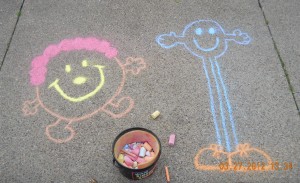
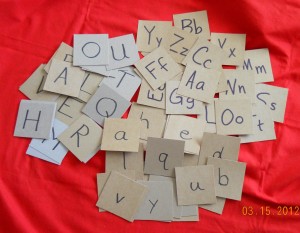

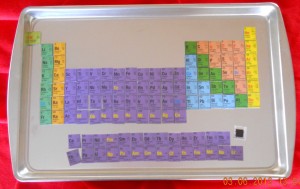
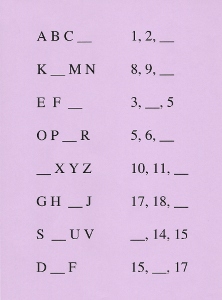
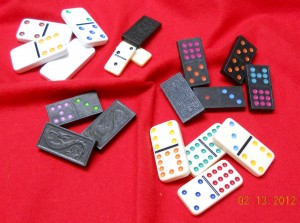
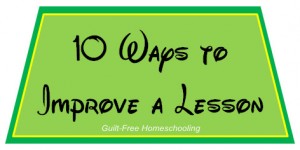


 Guilt-Free Homeschooling is the creation of Carolyn Morrison and her daughter, Jennifer Leonhard. After serious disappointments with public school, Carolyn spent the next 11 years homeschooling her two children, from elementary to high school graduation and college admission. Refusing to force new homeschooling families to re-invent the wheel, Carolyn and Jennifer now share their encouragement, support, tips, and tricks, filling their blog with "all the answers we were looking for as a new-to-homeschooling family" and making this website a valuable resource for parents, not just a daily journal. Guilt-Free Homeschooling -- Equipping Parents for Homeschooling Success!
Guilt-Free Homeschooling is the creation of Carolyn Morrison and her daughter, Jennifer Leonhard. After serious disappointments with public school, Carolyn spent the next 11 years homeschooling her two children, from elementary to high school graduation and college admission. Refusing to force new homeschooling families to re-invent the wheel, Carolyn and Jennifer now share their encouragement, support, tips, and tricks, filling their blog with "all the answers we were looking for as a new-to-homeschooling family" and making this website a valuable resource for parents, not just a daily journal. Guilt-Free Homeschooling -- Equipping Parents for Homeschooling Success!

Recent Comments